Taxonomic Classification:
Actaea racemosa
Common Name:
Black Cohosh
Description:
Perennial, 1-2 m, pubescent or glabrate. Leaves 2-3 ternately (or more) compund; leaflets 3-10 x 2-10 cm, variable in shape, cuneate to truncate, acute to acuminate, coarsely and sharply toothed, cleft or incised. Inflorescenes racemes, 1+, 1-9 dm, terminal and subterminal; pedicels 5-10 mm in fruit; sepals usually 5, 4-5 x 4 mm, caducous; stamens 8-10 mm; carpels 1; stipes lacking. Fruits follicles, 5-9 mm, firm-walled, ovoid or broadly ellipsoid, transversely veined, pubescent; seeds 2.5-3 x 1.5-2 mm wide, horizontally in 2 rows, brownish or reddish, laterally flattened, angled or slightly winged, smooth or rough but not chaffy. PHENOLOGY: May-August. HABITAT: Mesic to dry forests, usually in base-rich soils; especially abundant in rich cove forests and rich montane oak-hickory forests.
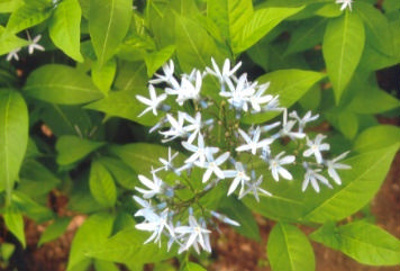
Taxonomic Classification:
Amsonia tabernaemontana
Common Name:
Blue star
Description:
1-3 ft., erect-stemmed perennial. Leaves alternate, entire, pinnately veined. Inflorescences terminal or axillary, occasionally reduced to a single flower; flowers blue, radial, sepals usually 5, petals usually 5 (forming various shaped corollas), corona of staminal outgrowth often present, petal-like, hood or horn shaped. Ovaries superior; carpels usually 2; ovules 2-many in each ovary. PHENOLOGY: March to May. HABITAT: Part shade, wet to moist sandy soils.
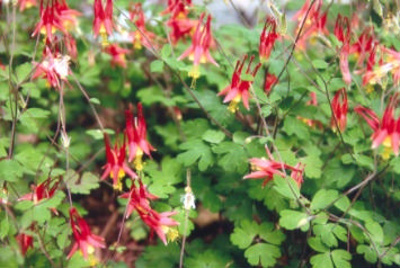
Taxonomic Classification:
Aquilegia canadensis
Common Name:
Columbine
Description:
Herbaceous perennial wildflower features drooping, bell-like, 1-2″, red and yellow flowers (red sepals, yellow-limbed petals, 5 distinctive red spurs and a mass of bushy yellow stamens). Elongated petioles, broadly obovate to circular leaflets (up to 4 x 4 cm). Height is 15–90 cm (6–35 in). Easily grown in average, medium, well-drained soil in full sun to part shade. Wide range of soil tolerance as long as drainage is good. Prefers rich, moist soils in light to moderate shade. Blooms March-May.
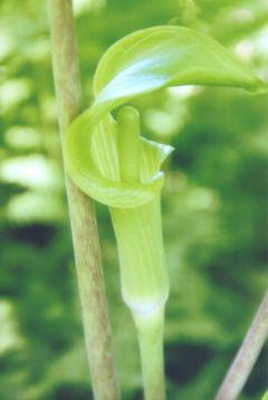
Taxonomic Classification:
Arisaema triphyllum
Common Name:
Jack-in-the-pulpit
Description:
Herbaceous perennial 12″-26″ in height with trifoliate leaves grown from a stem produced by a corm. The inflorescences (clusters of flowers) are shaped irregularly and grow up to 8 cm long. They are greenish-yellow or fully green with purple or brownish stripes. Flowers from April to June, producing berries about 1cm wide, green at first but red when ripe (late summer and early fall). This plant is not self pollinating.
Taxonomic Classification:
Asarum canadense
Common Name:
Canada Ginger
Description:
Perennial. Leaves a pair, 4-17 cm long and wide, cordate to reniform, membranous, pubescent; petioles to 2.5 dm, villous. Flowers on stout peduncles 1-5 cm; calyxes campanulate, maroon to green; calyx tubes 4-20 mm; lobes 3, 5-35 mm, spreading or ascending to reflexed, filiform-attenuate with slender tip to 20 mm or, sometimes, simply acute. Capsules crowned by a persistent calyx. PHENOLOGY: April-May. HABITAT: Rich, mesic to dry-mesic upland forests and well-drained floodplain forests.
Taxonomic Classification:
Asclepias tuberosa
Common Name:
Butterfly weed
Description:
Perennial. Stems solitary or, often, clustered from thick root crowns, 2-9 dm, hirsute to hispid; sap not milky. Leaves alternate, 4-12 x 0.7-2 cm, obovate to oblanceolate, cuneate at the base; margins flat, pilose or hispid, especially beneath; petioles lacking or very shorts. Umbels terminal or scattered in racemes along the branches or in helicoid cymes, wide, hemispheric, many-flowered; pedicels deflexed in fruit; corollas bright yellow to orange-red or bright orange; lobes 5-9 mm, oblong reflexed; corollas 4-7 mm diam., hoods 4-7 mm, greatly exceeding gynostegia, erect, with lateral margins lacking teeth or bearing obscure teeth below the middle. PHENOLOGY: May-August, August to September. HABITAT: Dry woodlands, clearings, fields, pastures, and roadsides.
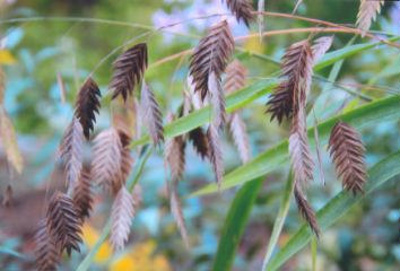
Taxonomic Classification:
Chasmanthium latifolium
Common Name:
River oats
Description:
A perennial grass bearing large, drooping, oat-like flower spikelets from slender, arching branches. Culms 0.5-2m; nodes and internodes glabrous. Blades 2.5dm x 0.2-2.5cm, soft, spreading, lanceolate, both surfaces glabrous, with a few long trichomes basally; margins scaberulous; sheaths glabrous, shorter than the internodes, with margins scarious; ligules erose or ciliate, 0.3-1mm. Panicles 1-2.5 x 0.2-2dm, open, nodding or drooping; branches spreading, flexuous, scabrous; spikelets 1-4 x 1-2 cm, ovate or lance-ovate, greenish, nodding on slender pedicels, with 6-20 florets; glumes 5-7 mm, 7-9 veined; lemmas closely imbricate, fertile lemmas 7-15mm, 11-17 veined; sterile lemmas usually 2, 6-8mm, 11-13 veined; paleae 6-7mm. Grains 3-5mm, dark red. PHENOLOGY: June-October. HABITAT: Well-drained floodplain forests, hummocks of alluvial swamps, rocky or sandy river shores and bars; less frequantly in tidal swamps, periodic seepage areas of mafic and calcareous woodlands and barrens. Avoid planting in continuous full sun, as its leaves turn yellowish without adequate shade. The more water it receives, the more tolerant it will be of intense sun, but it still prefers shade.
Taxonomic Classification:
Chelone lyonii
Common Name:
Pink Turtlehead
Description:
Perennial herbs. Stems upright, simple or sparingly branched, mostly glabrous. Leaves cauline, opposite, large, serrate, usually glabrous. Inflorescences terminal spikes or clusters, dense; bracts or bractlets 2 or 3, imbricate, hiding the short pedicels, ovate, concave; flowers large; calyxes deeply 5-parted, regular; tubes indistinct; sepals imbricate, broadly elliptic or widely ovate, obtuse or rounded; throats inflated, somewhat triangular in cross section, glabrous eventually. PHENOLOGY: July-September. HABITAT: Man made or disturbed habitats, shores of rivers or lakes, edges of wetlands.
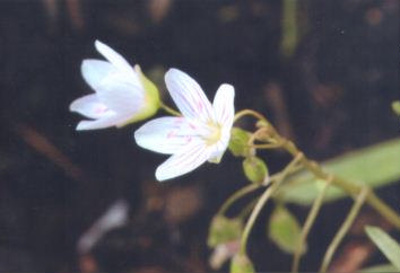
Taxonomic Classification:
Claytonia virginica
Common Name:
Spring beauty
Description:
A herbaceous perennial, 0.5-4dm, stems 5-40cm. Basal leaves, 3-14 x 0.5-1.3 cm, linear, petiolate; cauline leaves 1-10cm, linear, usually opposite, sessile. Racemes 6-20 flowered; pedicels 1-4cm; pedicels subtended by bracts 2-10 mm, firm, herbaceous; sepals 2, 3-9mm, blunt or bluntish; petals 9-15mm, white to pink with deeper pink stripes. Capsules 3-6 mm diam., ovoid to subglobose, longitudinally dehiscent; seeds 6, 2-3 mm diam., round, flat, minutely plose, lustrous, dark. Plant disappears from above ground shortly after the seed capsules have ripened. PHENOLOGY: March to May. HABITAT: It is found primarily in the moist woods of the eastern mountains and extends westward to Minnesota. Most characteristic of, but not restricted to, base-rich soils.

Taxonomic Classification:
Coreopsis major
Common Name:
Greater coreopsis
Description:
Perennial. Rhizomes long, slender. Stems 4-10dm, erect, with 6-12 nodes below the inflorescence, pubescent. Leaves 2.5-5.5 x 0.6-1.5 cm, cauline, palmately and ternately divided in 3 to the base, thus appearing as 6 leaves whorled at a node, pubescent; leafelets or segment 3-9 x 1-3 cm, oval to lanceolate or elliptic to linear, cuneate to attenuate basally, acuse or obtuse, with non-thickened margins; petioles lacking. Corymbs diffuse, heads several or many; peduncles 0.2-7 cm; outer phyllaries 3-6 mm, linear; inner phyllaries low becoming purplish or deep red. Cypselae 4-6 x 1.3-4 mm, oblong to elliptic or obovate; pappi lacking or of awns to 0.5 mm. PHENOLOGY: May to July. HABITAT: Sandy or rocky slopes and hills. Occurs on a wide range of substrates, from acidic to highly calcareous.
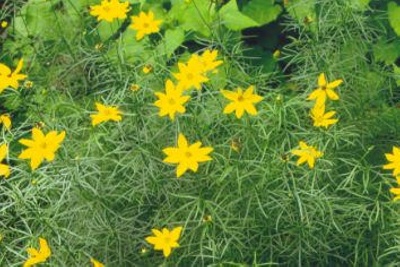
Taxonomic Classification:
Coreopsis verticillata
Common Name:
Whorled coreopsis
Description:
Perennial. Rhizomes slender, yellow when fresh. Stems 1.5-11 dm, erect, with 6-12 nodes below the inflorescence, glabrous but pubescent or hispidulous at nodes. Leaves 3-7 cm, cauline, ternately parted to the base (thus appearing whorled), with at least the central segments pinnatifid or again ternate, glabrous; segments 0.2-1.2 mm wide, linear-filiform to linear, acute, wit thickened or revolute margins; petioles lacking. Corymbs diffuse; peduncles 0.5-10cm; outer phyllaries 3-9 mm, linear; inner phyllaries 6-7 mm, lance-ovate; ray florets 15-30 mm; disk florets 3.5-5 mm, yellow, sometimes drying blackish. Cypselae 3-5 x 1-2.5 mm, oblong or oblong-obovate; pappi obsolete or of two 0.5 mm awns. PHENOLOGY: May to July. HABITAT: Sandy, well-drained, acidic soil.
Taxonomic Classification:
Dicentra eximia
Common Name:
Wild Bleeding Heart
Description:
Perennial; rhizomes short, stout, scaly, lacking bulblets. Leaves 5-25 cm, ovate, pinnate-ternately decompound; ultimate segments elliptic or obovate, dentate. Panicles equaling or overtopping the leaves, with nodding flowers; sepals 3-8 mm, cordate-acuminate, erose or entire; corollas 17-25 mm, pink; spurs short and rounded; tips of outer petals 4-7 mm, acuminate, divergent, lax; inner petals surpassed by apices of crest. Capsules 16-25 x 3-5 mm, oblong to ovoid. PHENOLOGY: April-June; July-August. HABITAT: Exposed to partly shaded cliffs, ledges, pavements, and talus of sandstone, quartzite, shale, and granite, and other acidic rocks; somewhat anomalous populations occur on dry, cobbly terraces and stream banks formed in massive alluvial fans at the western foot of the Blue Ridge in Augusta County.
Taxonomic Classification:
Dodecatheon meadia
Common Name:
Shooting star
Description:
Perennial. Roots fleshy. Scapes 1.5-6 dm, robust. Leaves 6-30 x 1-10 cm, in basal rosette, elliptic to oblanceolate, usually tinged or marked with red at the base, abruptly to gradually narrowing to petiole, round at apex, entire or toothed; petioles margined. Umbels of 3-125 flowers; pedicels unequal, recurved in flower, erect in fruit; bracts 2-8 mm, lanceolate or linear; flowers 1.8-2 cm, lilac or pink or white; calyx lobes 3-9 mm, triangular lanceolate or lanceolate, acute, reflexed in flower, erect in fruit; tubes about 1/2 as long as lobes; petals 1.5-2.5 cm, united only at base, narrow, reflexed; stamens 5, 6-10 mm, extending forward; filament tubes 1-2 mm; anthers 6.5-10 mm. Capsules 7-18 mm, dark reddish brown, narrowly ovoid to barrel shaped to ellipsoid or lanceolate, thickest near base, 5-valved above, dehiscent along sutures for a short distance from apex; seeds 1.2-1.5 mm, dark reddish brown. PHENOLOGY: Late March-Early June; Late May-June. HABITAT: Open often rocky forests, woodlands, and barrens over calcareous and mafic rocks, including limestone, dolomite, metabasalt, pyroxene-bearing granites, siltstone, metasiltstone, and calcareous sandstone; also in outcrop-face seeps and, rarely, seepage swamps on these substrates.
Taxonomic Classification:
Gentiana clausa
Common Name:
Bottled Gentian
Description:
Perennial 4-8 dm. Stems 1-few from a crown, unbranched, glabrous. Leaves to 10 cm, elliptic to oval, acuminate, entire to minutely rough-ciliate, sessile, sheathing. Involucres of terminal inflorescences of 4-6 leaves; flowers in 2-6 flowered sessile cymes, terminal and upper-axillary, with the axillary occasionally pedunculate; calyx tubes to 1 cm, with oblong to ovate, rough-ciliate, acute to acuminate lobes to 6 mm; corollas 3-5 cm, porcelain-blue to blue-violet, oblong to narrowly obdeltoid, scarely opening; lobes about as long as plaits, slightly incurved, oblong; plaits cleft, 2-3 toothed or lobed. Capsules 2-3 cm, ellipsoid; seeds brown surrounded by a tan margin, flattened, oblanceolate. PHENOLOGY: September-October. HABITAT: Floodplain forests and swamps, seeps, fens, seepage swamps, wet meadows, and clearings; perhaps more restricted to base-rich soils than other Virginia gentians.
Taxonomic Classification:
Hydrastis canadensis
Common Name:
Goldenseal
Description:
Plants 1.5-5 dm, from yellowish rhizome, colonial, pubescent. Basal leaves 1; cauline leaves 2, near summit of the stem; leaves 1-2.5 dm wide, rounded, short-acuminate, cordate at base, palmately 3-9 lobed, sharply doubly serrate, palmately veined. Flowers 8-10 mm wide, solitary, greenish white; peduncles 0.5-2cm, densely hirsute; sepals 3, caducous; stamens and carpels numerous; filaments 5-8 mm. Berries deep crimson. PHENOLOGY: April; May-June. HABITAT: Rich, mesic and dry-mesic forests over calcareous and mafic rocks, especially limestone and dolomite; occasionally in rich alluvial forests and dry rocky woodlands.
Taxonomic Classification:
Impatiens capensis
Common Name:
Spotted Touch-Me-Not
Description:
Annual 5-15 dm. Stems branched above, glabrous. Leaves 3-11 x 3-8 cm, ovate or elliptic, crenate-serrate with mucronate teeth, pale or glaucous beneath; petioles to 10 cm. Inflorescences racemes, 2-4 flowered, widely spreading; bracts linear-subulate; flowers 1.8-3 cm, pendent, depp orange to red or orange-yellow or, occasionally, whitish or cream colored, mottled with red or reddish brown; sepals with spurs 7-10 mm, parallel to sac, with saccate portion longer than broad and heavily spotted. Capsules to 2 cm, glabrous; seeds 4-5 mm, elliptic-ovate, dark brown. PHENOLOGY: May-November. HABITAT: Floodplain forests, alluvial forests, tidal swamps, freshwater tidal swamps, seeps and seepage swamps, upland depression swamps, fens, beaver ponds, ditches, and other disturbed wetlands; occasionally in mesic upland forests.
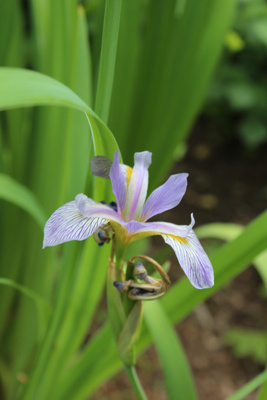
Taxonomic Classification:
Iris virginica ver. Shrevei
Common Name:
Shreve’s Iris
Description:
Perennial. Rhizomes thick, often forming extensive colonies. Stems to 10dm, unbranched or 1 or 2 well-developed branches; flowering stems soon low-arching with maturing fruits on the ground or in the water. Leaves 20-110 x 1-3 cm, broadly linear to broadly ensiform, arched-recurving or falling to the ground, green; basal tufts buff or pale brown at base. PHENOLOGY: April-May; July-September. HABITAT: Freshwater and oligohaline tidal marshes, tidal swamps, maritime swamps, alluvial swamps, wet flatwoods, floodplain pools, fens, wet meadows, stream margins, and disturbed wetlands such as ditches and beaver ponds.
Taxonomic Classification:
Lobelia cardinalis
Common Name:
Cardinal Flower
Description:
Perennial 4-25 dm, from basal offshoots, not rhizomatous. Stems usually simple, glabrate. Leaves 4-20 x 1.5-5.5 cm, lanceolate to lance-ovate, acute to acuminate, irregularly serrate, glabrous or hirtellous; petioles to 3 cm, reduced upward. Racemes 0.5-6 dm, simple, not secund; pedicels 5-15 mm, hairy; usually shorter than the bracts, with 1 or 2 small bracteoles near the base; bracts 1-5 cm, linear or narrowly lanceolate; calyx lobes 6-22 mm, linear to narrowly lanceolate, entire; corollas 3-4.5 cm, bright red, rarely white. Capsules 0.8-1.2 cm broad, broadly ovoid to oblate or spheric; seeds 0.7-1 mm. PHENOLOGY: July-October. HABITAT: Floodplain forests, alluvial swamps, seepage swamps, maritime swamps, tidal swamps, tidal freshwater and oligohaline marshes, wet meadows, ditches, and low roadsides.
Taxonomic Classification:
Lonactis linariifolia
Common Name:
Stiff-leaved aster
Description:
A herb that can grow up to 70 cm tall. Leaves are green, long and narrow, up to 4 cm long. The plant usually produces several flower heads in a flat-top array. Each head has blue, white, or violet ray flowers surrounding numerous yellow disc flowers.
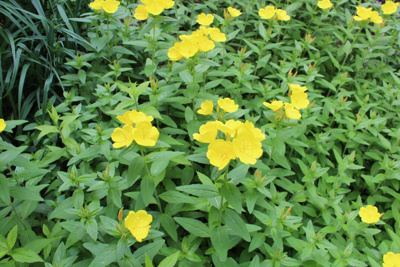
Taxonomic Classification:
Oenothera fruticose
Common Name:
Sundrops
Description:
Perennial. Stems 2-8 dm, erect, simple to branched above, variously stigrose or spreading hairy to nearly glabrous below the inflorescences. Leaves in rosettes first year, ovate to spatulate; stem leaves 2-11 x 0.5-3 cm, elliptic or lanceolate to oblanceolate, attenuate at base, acute, entire to subentire, minutely puberulent; petioles lacking or to 10 mm. Inflorescences at tip of stems and branches, in axils of reduced leaves; flowers diurnal, few to several in compact clusters that only seldom nod at the tip; pedicels to 2 cm; calyx tubes 5-25 mm, appressed- to spreading-pubescent, with the hairs not gland tipped; sepals 0.5-2 cm; petals 0.8-2.2 cm, notched at summit, yellow; anthers 4-9 mm. Capsules 3-11 x 3-4.5 mm, strongly tetragonal or narrowly 4-winged, clavate, tapering to short or elongate pedicellike bases; pubescence appressed or divergent, not glandular, PHENOLOGY: April-August. HABITAT: Mesic to dry forests and woodlands, barrens, outcrops, clearings, peaty swales, ditches, fields, and roadsides.
Taxonomic Classification:
Penstemon smallii
Common Name:
Beardtongue
Description:
Numerous, tube shaped, dar-pink, white throated flowers are borne on upright, branched stalks up to 2 1/2 feet high. Differing from other eastern penstemons, the flowering branches extend down into the axils of the leafy stems, giving the plant a bushy appearance. The shiny, opposite leaves have attractive, dark veins and clasping, heart shaped bases. The basal rosette of leaves turns reddish-bronze in the winter. PHENOLOGY: April-June. HABITAT: Wood margins; exposed or shaded cliffs and banks.
Taxonomic Classification:
Phlox divaricata
Common Name:
Blue Phlox
Description:
Perennial, rhizomatous. Stems 1.2-5.5 dm (sterile stems much shorter), erect or decumbent, lossely villous to finely viscid-pubescent, nodes 4. Leaves 2.5-5.5 x 0.4-1.5 cm, elliptic to lance-ovate or oblong, obtuse or acute but not sharply pointed, sparsely villous or pubescent; some trichomes glandular. Inflorescences corymbose-paniculate, lossely flowered, becoming lax and divergent, glandular-hairy; branches on distinct peduncles; pedicels 5-12 mm; calyxes 7-13 mm, densely glandular; teeth linear, mucronate or subulate tipped, equaling or exceeding the tube; corollas pale blue-purple varying to red-purple or white; tubes 1-2 cm, glabrous; lobes 10-16 mm, obovate to obcordate; stamens included; styles cleft about 1/2 their length. PHENOLOGY: April-May. HABITAT: Rich, well-drained floodplain forests, rich mesic cove and slope forests; occasionally in drier, calcareous forests.
Taxonomic Classification:
Phlox stolonifera
Common Name:
Creeping Phlox
Description:
Perennial, stoloniferous. Prostrate stems well developed, rooting and mat-forming and bearing flowering shoots at nodes, villous; flowering stems 1-4 dm, erect or diffusely spreading, villous above; nodes few, distant. Leaves of basal shoots or rosettes 1.5-7.5 x 2.3 cm, spatulate or obovate, evergreen, petiolate; leaves on flowering stems 1.5-4.5 x 0.5-1.6 cm, lanceolate or oblong to spatulate, pubescent, sessile or nearly so. Inflorescences cymes or corymbs, open, few-flowered, viscidpilose or -villous; calyxes 9-11 mm, glandular-hairy; teeth about equaling tube, lanceolate or linear-subulate, outcurved; corollas red-purple to pink or lavendar (rarely white); tubes 2-2.5 cm, glandular-pubescent; lobes 10-17 mm, round-obovate; anthers slightly exserted; styles united. PHENOLOGY: April-May. HABITAT: Cove forest (both acidic and rich) and montane alluvial forests; occasionally in dry-mesic slope forests.
Taxonomic Classification:
Rudbeckia fulgida var. sullivantii
Common Name:
Black-eyed Susan
Description:
Perennial, stoloniferous. Stems 3-12 dm, branches spreading to erect, glabrous or minutely strigose-hispid to moderately villous-hisrute, with hairs spreading to appressed. Basal and lower cauline leaves 2.5-12.5 x 0.5-5 cm, lanceolate or oblanceolate to oblong or elliptic, rounded or subcordate to cuneate or attenuate basally, acute to acuminate, entire or remotely serrate to denticulate or coarsely serrate, scabrous above, minutely strigose to villous-hirsute; cauline leaves reduced, sometimes slightly clasping; petioles long on lower leaves, reduced to lacking upward, winged. PHENOLOGY: August-October. HABITAT: The species occurs in dry to moist woodlands, barrens, clearings, old fields, meadows, and roadsides.
Taxonomic Classification:
Sanguinaria canadensis
Common Name:
Bloodroot
Description:
Perennial 1-4 dm, acaulescent, from thick rhizomes, with bright orange-red juice. Leaves basal only, usually 1, 5-20 cm wide, reniform, irregularly palmately lobed to parted, entire or, rarely, crenate, glabrous, often glaucous beneath. Flowers solitary, scapose; scapes 5-15 cm at anthesis; sepals 2; petals 8-16, 1.5-3 x 0.5-0.9 cm, 4 usually longer than others, white (rarely pink), elliptic; stamens about 2 x as many as petals, yellow; stigmas 2-lobed. Capsules 2.5-6 x 0.5-1 cm, 2-valved, fusiform; seeds 2-3 mm, ellipsoid, numerous, smooth, conspicuously crested, black or russet. PHENOLOGY: March-April; April-May. HABITAT: Mesic to dry-mesic upland forests, dry calcareous forests and woodlands, well-drained floodplain forests; most numerous in moderately to strongly base-rich soils.
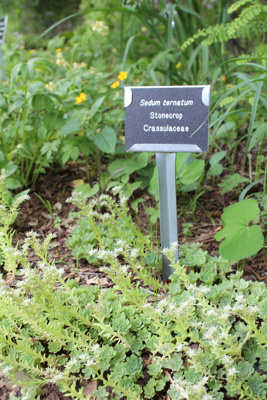
Taxonomic Classification:
Sedum ternatum
Common Name:
Stonecrop
Description:
Perennial, mat-forming. Sterile branches loosely spreading or prostrate, with 1 or 2 whorls of 3 or 4 leaves. Flowering stems 5-20 cm, erect, arising from sterile rosette. Sterile branch leaves 0.5-3 cm, cuneate-obovate, rounded, entire, flat, green; terminal rosette leaves 6, 1-2.5 cm, crowded; lower cauline leaves 0.5-2 cm, in whorls of 3 or 4, spatulate, entire, flat; upper cauline leaves opposite or scattered, oblanceolate to naerly linear, dark green. PHENOLOGY: April-June; May-July. HABITAT: Well-drained floodplain forests, mesic upland forests, shaded ledges and outcrops; usually but not always, in base-rich soils.
Taxonomic Classification:
Sisyrinchium angustifolium
Common Name:
Blue-eyed grass
Description:
Perennial, 2-5 dm, erect, usually not fibrillose at base, loosely tufted. Leaves 2-5 mm wide, shorter then scapes, grass like, bright green, turning darker in drying; scapes 2.3-5 mm wide, flat, ascending, flexuous or, rarely, geniculate, broadly winged, with wings individually wider than the central part and minutely denticulate on margins. Inflorescences borne singly; spathes green, erect to 4 cm, about equal or the outer slightly longer; margins connate at base; perianths blue or, rarely, white; tepals 7-10 mm. Capsules 4-7 mm; seeds to 1.2 mm, prominently reticulate. PHENOLOGY: April-June; May-July. HABITAT: Mesic to dry upland forests, woodlands, fields, meadows, and flood-plain forests.
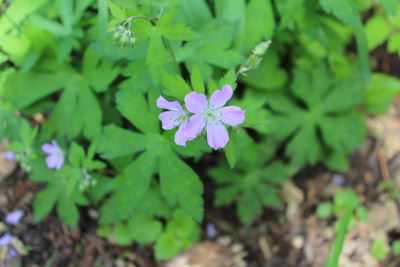
Taxonomic Classification:
Stenanthium gramineum
Common Name:
Featherbells
Description:
Perennial. Bulbs slender, ellipsoid; outer coat fibrous, 3-8 cm. Stems 2.5-22 dm tall, 0.15-2 cm thick at the lowest exposed internodes. Leaves ascending, numerous and rather crowded below, thin and membranous to firm to coriaceous, opaque to translucent, with ribs mostly immersed in tissue or raised producing corrugated surfaces; larger leaves 0.2-3 cm wide; upper leaves reduced to small bracts. PHENOLOGY: July-Early September; August-October. HABITAT: Dry to occasionally mesic acidic forests, woodlands, and clearings; especially frequent in higher-elevation oak/heath forests and pine-oak/heath woodlands; also in acidic seeps and seepage swamps east of the mountains.
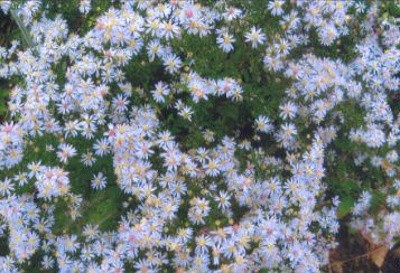
Taxonomic Classification:
Symphyotrichum cordifolium
Common Name:
Heart-leaved aster
Description:
Perennial. Rhizomes short. Stems 2-20 dm, erect, single or several in clumps. Leaves 3-15 x 2.5-8 cm mostly cauline, rather thin to firm, conspicuously serrate; petioles long on lower leaves. Inflorescences diffuse, many-headed; branches subsimple to intricately forking, loosely ascending to widely spreading or divergent. Small bluish to purplish ray florets with yellow to red disk florets. PHENOLOGY: September through October. HABITAT: Mesic to dry upland forests, woodlands, and shaded road banks; tolerant of a range of soil chemistries.
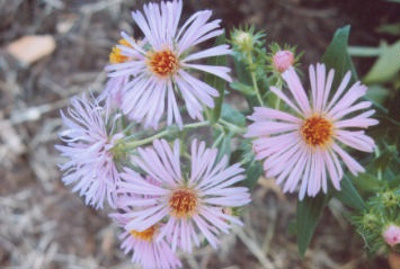
Taxonomic Classification:
Symphyotrichum novae-angliae
Common Name:
New England aster
Description:
Flowering herbaceous perennial plant. Leaves 2-12 x 0.4-2 cm, chiefly cauline, lanceolate to elliptic-lanceolate in shape. Inflorescences corymbs or panicles, short, with several to many heads in clusters as branch tips. Ray florets 40-100, 1-3 cm, violet-purple (or, rarely, pink); disk florets yellow. PHENOLOGY: September to October. HABITAT: Calcareous fens and spring marshes, wet meadows, and alluvial fields. Commonly cultivated and escaped to roadsides and clearings.
Taxonomic Classification:
Symphyotrichum patens
Common Name:
Late Purple Aster
Description:
Perennial. Rhizomes slender, creeping, colonial; caudices short. Stems 1-3, 2-15 dm, usually simple to the inflorescences, with 12-30 nodes below branches, slender, firm or brittle, shortly and loosely hairy or canescent, scabrous. Leaves 2-15 x 0.7-4.5 cm, cauline, divergent, ovate to oblong or lanceolate to oblanceolate, often contracted below the middle, auriculate-clasping at base and almost meeting around the stem, acute to obtuse or mucronate-tipped, entire or, sometimes, ciliate-crenulate, scabrous, especially on margins, hairy; lowers leaves soon decidous; petioles lacking. Inflorescences solitary heads terminating slender branchlets with the stems divaricately branched, or the branches altogether parts of panicles, diffuse, few- to many-headed; branches diffuse, divaricate or subascending; inflorescences bracts many, flat, foliaceous; peduncles or branchlets slender, stiff, bracteate; involucres 5-9 x 7-10 mm, turbinate or turbinate-campanulate, ciliate, puberulent or glandular; phyllarries in 3 or 4 series, imbricate, firm, oblanceolate or oblong to oblong-linear, scarious, with green and spreading tips; ray florets 15-30, 0.8-2 cm, blue to violet or purple or, rarely, pink; disk florets yellow to purple or red. Cypselae 2.8-3.3 mm, oblanceolate to ellipsoid, ribbed, pubescent or shortly sericeous, tan; pappi 5-7 mm. PHENOLOGY: Late August-Early November; October-November. HABITAT: Dry-mesic to dry upland forests, woodlands, barrens, clearings, and road banks; tolerates a range of soil chemistries.
Taxonomic Classification:
Tiarella cordifolia
Common Name:
Foamflower
Description:
Perennial from rootstocks or rhizomes, with or without stolons. Flowering stems 1-5 dm, erect, pubescent. Leaves 4-14 cm long, to 10 cm wide, broadly ovate or nearly orbicular, cordate, acuminate, palmately veined with 3-7 lobed, serrate to crenate or dentate, glabrate to pubescent throughout or downy beneath, alternate on stolons or rhizomes; lobes sharp to obtuse; petioles elongate, pubescent. Inflorescences racemes, 3-15 cm, crowded at first, glandular-puberulent, bracteate; pedicels 1-13 mm, reduced upward; flowers to 6 mm wide, white or pink-tinged; calyxes campanulate; calyx tubes to 1 mm; sepals 2-3.5 mm, elliptic-obovate to oblong, blunt; petals 3-5 mm, oblong or lanceolate to elliptic, entire or somewhat dentate; stamens 2-5 mm, exserted. Capsules 6-12 mm, reflexed; seeds to 1.2 mm, ellipsoid, lustrous, black. PHENOLOGY: April-June. HABITAT: Cove forests, mesic to dry-mesic slope forests, shaded rock outcrops, and well-drained alluvial forests.
Taxonomic Classification:
Tradescantia virginiana
Common Name:
Virginia Spiderwort
Description:
Perennial. Stems 0.5-6 dm, erect or ascending, with 2-5 nodes, glabrous to puberulent above. Leaves 10-35 x 0.5-2.5 cm, linear-lanceolate, long-acuminate, glabrous, not glaucous, thin; sheaths usually pubescent, white hirsute fringed. Inflorescences terminal, solitary cymes, sometimes from uppermost nodes; bracts often wider and longer than the leaves; pedicels 1.5-3 cm, pilose with eglandular hairs to 1 mm; sepals 7-16 mm, inflated. foliaceous, usually uniformly pilose or villous with eglandular hairs to 2 mm; petals 1.2-1.8 cm, blue or purple or, sometimes, rose or white. Capsules 4-7 mm, ellipsoid; seeds 2-3 mm. PHENOLOGY: April-June. HABITAT: Well-drained floodplain forests, mesic to dry upland forests, and rocky woodlands around outcrops; usually in moderately to strong base-rich soils.
Taxonomic Classification:
Trillium erectum
Common Name:
Red Trillium
Description:
Perennial. Rhizomes 2-6 x 1-3 cm. Stems 2-6 dm, green to purplish. Leaves 8-19 x 5.6-25 cm, rhombic to rhombic-ovate, often wider then long, acuminate, sessile or nearly so. Pedicels 1-9 cm, erect or divergent, occasionally hiding the flowers below the leaves; sepals 2-4 x 0.7-1.5 cm, lanceolate-acuminate, horizontals; petals 2-4.5 x 1-2 cm, lanceolate to narrowly ovate to elliptic, usually maroon or white, rarely, pink or yellow or green; stamens 0.8-1.5 cm; filaments 2-7 mm; anther connectives as long as or slightly shorter than the anther sacs; stigmas erect to horizontal, maroon or, rarely, white. Berries 1.5-2.5 cm, ellipsoid to ovoid, dull purple-red. PHENOLOGY: April-May; July-August. HABITAT: Rich or, occasionally, acidic cover forests; mesic and dry-mesic slope forests over mafic or calcareous substrates; northern hardwood forests, seepage swamps hummocks.
Taxonomic Classification:
Trillium grandiflorum
Common Name:
Large-flowered trillium
Description:
Perennial. Rhizomes 2-4 x 1-3 cm. Stems 2-5 dm, green or, rarely, purple. Leaves 6-16 x 4-12 cm, ovate to rhombic-ovate or lanceolate, acute to acuminate, sessile or on petioles to 12 mm. Pedicels 1.5-12 cm, erect, usually holding the flowers well above the foliage; sepals 3-6 x 1.8-2.5 cm, lanceolate, horizontally spreading; petals 4-8 x 2-4.5 cm, elliptic to elliptic-ovate or oblanceolate, white, usually changing to pink with age; stames 1.5-2.5 cm; another connectives slightly shorter than the anther sacs; stigmas erect-ascending, white. PHENOLOGY: April-May; July-August. HABITAT: Cove forests, mesic to dry-mesic slope forests, northern hardwood forests, Northern Red Oak forests, and seepage swamp hummocks; most characteristic of and numerous in (but not restricted to) soils weathered from mafic and moderately to strongly calcareous rocks.
Taxonomic Classification:
Trillium luteum
Common Name:
Yellow trillium
Description:
Perennial. Rhizomes to 6 x 0.2 cm. Stems 1-3 dm, reddish purple. Leaves 6-19 cm long and wide, deltoid-ovate to ovate-lanceolate or widely elliptic, acuminate, sessile or nearly so. Flowers sessile; sepals 3-5 x 0.7-1.5 cm, lanceolate, erect to divergent; petals 4.5-6.5 x 1.6-2.5 cm, elliptic-lanceolate, yellow; stamens 1.2-1.8 cm; filaments 1-3 mm; anther connectives extended < 1mm beyond the anther sacs; stigmas erect, greenish white. Berries 1.3-1.7 cm, broadly ovoid, maroon-red. PHENOLOGY: Middle of March-April; Late May-June. HABITAT: Rich floodplain forest and adjacent limestone slopes.
Taxonomic Classification:
Uvularia grandiflora
Common Name:
Large-flowered Bellwort
Description:
Taxonomic Classification:
Uvularia perfoliata
Common Name:
Perfoliate Bellwort
Description:
Perennial. Stolons present, to 1.5 dm, slender, white; plants colonial. Stems 2-4.5 dm at anthesis, forking above, bearing 2-4 leaves below fork and to 6 on branches. Basal and low-cauline leaves bladeless; other cauline leaves perfoliate, elliptic to oval, acutish, glabrous, often glaucous below, with the uppermost to 7 cm and the rest 3.5-10 x 1.5-4 cm. Flowers generally solitary; sepals and petals 1-3 cm, acute or acuminate, glandular-papillose on the inner surfaces, straw-yellow colored; stamens to 12 mm; ovaries sessile, obovoid; styles 8-10mm; stigma lobes 3-5 mm. Capsules 7-10 mm, obovoid; each locule with 2 dorsal ridges and with 2 attenuate beaks at apex; seeds 2.5-3 mm, with largely fleshy aril at base. PHENOLOGY: April-Early May; June-August. HABITAT: Well-drained floodplain forests and mesic to dry uplands forests; most abundant on (but not restricted to) base-rich soils; also in dry rocky woodlands over mafic and calcareous rocks.
Taxonomic Classification:
Uvularia sessilifolia
Common Name:
Sessile-leaved Bellwort
Description:
Perennial. Stolons present; plants colonial. Stems 1-4.5 dm tall, 1-branched or simple, glabrous, at least above. Leaves 4-8 x 1-3 cm, elliptic, acute, sessile, glabrous, usually glacous, firm. Flowers 1 per stem; sepals and petals 13-25 mm, rounded to acute, smooth on inner surface, straw-yellow; stamens 8-16 mm; ovaries stipitate, sharply triangular; styles 7-13 mm; stigma lobes to 2 mm. Capsules 1-2.5 cm, ellipsoid to ovoid, sharply angled (rarely slightly winged); seeds 2.5-3 mm, rounded with aril small to obsolete. PHENOLOGY: Late March-Early May; August-October. HABITAT: Well-drained floodplain forests, stream banks, mesic to occasionally dry upland forests.
Taxonomic Classification:
Vernonia noveboracensis
Common Name:
New York Ironweed
Description:
Perennial. Stems 10-20 dm, glabrous to roughish-pubescent. Leaves 7-30 x 1.5-6.5 cm, lanceolate or lance-linear to lance-oblong, gradually narrowed to the base, long-acuminate to acute, serrate to nearly entire, slightly rough above, puberulent to thinly tomentose beneath, with lower sides not much paler than the upper. Inflorescences corymbiform to paniculiform, 0.5-3.5 dm wide, loose and open; heads 20-65 flowered; involucres 7-17 mm long and wide; phyllaries ovate or oblong at the base, with prolonged filiform tips 2-8 mm and loosely ascending to recurved-spreading, arachnoid-ciliate, glabrous on back, brownish purple or greenish. Cypselae 3-5 mm, hispidulous on ribs; pappi purplish or dark-tawny. PHENOLOGY: July-September; August-October. HABITAT: Floodplain forests, alluvial swamps, riverbanks and bars, riverside prairies, fens, calcareous spring marshes, freshwater to oligohaline tidal marshes, tidal swamps, wet meadows, low fields, clearings, and pastures; occasionally in mesic upland forets.



























